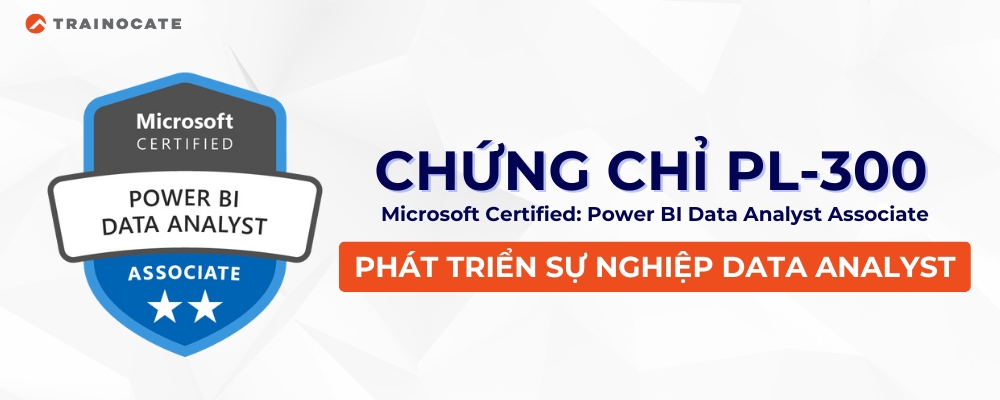PL-300T00: Microsoft Power BI Data Analyst
Tổng quan khóa học PL-300
Khóa học PL-300T00: Microsoft Power BI Data Analyst là một khóa học chính hãng do Microsoft cung cấp, giúp người học nắm vững được kiến thức và kỹ năng cần thiết để sử dụng Power BI trong công việc phân tích dữ liệu. Khóa học cũng là nền tảng chuẩn bị kiến thức cho chứng chỉ PL-300 Microsoft Certified: Data Analyst Associate - chứng nhận khả năng sử dụng Power BI để phân tích và trực quan hóa dữ liệu hiệu quả.
Khóa học PL-300 cung cấp kiến thức về Power BI như: cách truy cập và xử lý dữ liệu từ nhiều nguồn dữ liệu khác nhau, bao gồm cả dữ liệu quan hệ (relational data) và phi quan hệ (non-relational data); chuyển đổi và làm sạch dữ liệu; các phương pháp phân tích. trực quan hóa dữ liêu và tạo báo cáo phân tích.

Các kiến thức trong khóa học PL-300
- Nhập, làm sạch và chuyển đổi dữ liệu
- Mô hình hóa dữ liệu để tối ưu hiệu suất và khả năng mở rộng
- Thiết kế và tạo báo cáo cho phân tích dữ liệu
- Áp dụng và thực hiện phân tích báo cáo nâng cao
- Quản lý và chia sẻ dữ liệu báo cáo
- Tạo paginated reports trong Power BI
- Chuẩn bị kiến thức và kỹ năng cần thiết để thi lấy chứng chỉ PL-300 (Microsoft Certified: Power BI Data Analyst Associate)
Khóa học PL-300 dành cho ai?
Đối tượng của khóa học PL-300 Power BI này là các chuyên gia dữ liệu và các chuyên gia về BI (Business Intelligence) muốn học cách thực hiện phân tích dữ liệu một cách chính xác bằng cách sử dụng Power BI.
Khóa học này cũng dành cho những cá nhân muốn phát triển các báo cáo trực quan hóa dữ liệu từ các công nghệ nền tảng dữ liệu hiện có, tồn tại trên cả Cloud và On-Premises.
Điều kiện đầu vào
Khóa học PL-300 phù hợp với các Data Analyst và người có kinh nghiệm làm việc với dữ liệu trên đám mây. Các kiến thức nền tảng cần có là:
- Hiểu các khái niệm dữ liệu cơ bản.
- Kiến thức về làm việc với relational data trên đám mây.
- Kiến thức về làm việc với non-relational data trên đám mây.
- Kiến thức về các khái niệm phân tích và trực quan hóa dữ liệu.
Để hiểu biết tốt hơn về việc làm việc với dữ liệu trong Azure bạn hãy hoàn thành khóa học DP-900: Microsoft Azure Data Fundamentals trước khi tham gia khóa học này.
Nội dung khóa học PL-300
Module 1: Tìm hiểu về Data Analyst
- Tìm hiểu về các vai trò trong lĩnh vực data.
- Tìm hiểu về các nhiệm vụ của một nhà phân tích dữ liệu.
Module 2:Tìm hiểu về Power BI
- Tìm hiểu cách các dịch vụ và ứng dụng Power BI hoạt động cộng tác.
- Khám phá cách Power BI có thể làm cho doanh nghiệp của bạn hiệu quả hơn.
- Học cách tạo ra các hình ảnh và báo cáo hấp dẫn.
Module 3: Nhận dữ liệu trong Power BI
- Xác định và kết nối đến một nguồn dữ liệu.
- Lấy dữ liệu từ một relational database, như Microsoft SQL Server.
- Lấy dữ liệu từ một tệp, như Microsoft Excel.
- Lấy dữ liệu từ các ứng dụng.
- Lấy dữ liệu từ Azure Analysis Services.
- Chọn chế độ lưu trữ.
- Khắc phục các vấn đề về hiệu suất.
- Giải quyết các lỗi nhập dữ liệu.
Module 4: Chuẩn hóa, biến đổi và tải dữ liệu trong Power BI
- Giải quyết các bất thường, giá trị không mong muốn hoặc null, và các vấn đề về chất lượng dữ liệu.
- Áp dụng các giá trị thay thế user-friendly.
- Phân tích dữ liệu để bạn có thể tìm hiểu thêm về một cột cụ thể trước khi sử dụng nó.
- Đánh giá và biến đổi kiểu dữ liệu của cột.
- Áp dụng các biến đổi hình dạng dữ liệu cho cấu trúc bảng.
- Kết hợp các truy vấn.
- Áp dụng quy ước đặt tên thân thiện với người dùng cho các cột và truy vấn.
- Chỉnh sửa M code trong Trình chỉnh sửa nâng cao.
Module 5: Thiết kế một mô hình dữ liệu trong Power BI
- Tạo bảng dữ liệu chung
- Cấu hình many-to-many relationships
- Giải quyết các circular relationships
- Thiết kế các star schemas
Module 6: Giới thiệu về việc tạo các phép đo sử dụng DAX trong Power BI
- Xây dựng các quick measures.
- Tạo các cột tính toán.
- Sử dụng DAX để xây dựng các measures.
- Khám phá cách ngữ cảnh ảnh hưởng đến các DAX measures.
- Sử dụng hàm CALCULATE để thao tác với bộ lọc.
- Thực hiện time intelligence bằng cách sử dụng DAX.
Module 7: Tối ưu hóa mô hình cho hiệu suất trong Power BI
- Đánh giá hiệu suất của các measures, mối quan hệ và trực quan hóa.
- Sử dụng variables để cải thiện hiệu suất và xử lý sự cố.
- Cải thiện hiệu suất bằng cách giảm cấp độ cardinality.
- Tối ưu hóa các mô hình DirectQuery với lưu trữ cấp bảng.
- Tạo và quản lý các aggregations.
Module 8: Làm việc với các trực quan Power BI
- Thêm các visualization vào báo cáo.
- Chọn một visualization hiệu quả.
- Định dạng và cấu hình các visualization.
- Nhập một custom visual.
- Thêm một R hoặc Python visual.
Module 9: Tạo một câu chuyện dựa trên dữ liệu với báo cáo Power BI
- Thiết kế bố cục báo cáo.
- Thêm button, bookmark và selections.
- Thiết kế report navigation.
- Sử dụng các tương tác cơ bản.
- Sử dụng các tương tác nâng cao và drillthrough.
- Cấu hình định dạng có điều kiện.
- Áp dụng slicing, filtering và sorting.
- Xuất bản và xuất báo cáo.
- Bình luận trên các báo cáo.
- Sử dụng Performance Analyzer để tinh chỉnh báo cáo.
- Tối ưu hóa báo cáo cho việc sử dụng trên di động.
Module 10: Tạo bảng điều khiển (dashboards) trong Power BI
- Đặt chế độ mobile view.
- Thêm chủ đề cho các visuals trong dashboards của bạn.
- Cấu hình phân loại dữ liệu.
- Thêm real-time dataset visuals vào dashboards của bạn.
- Ghim một trang báo cáo trực tiếp vào dashboards.
Module 11: Thực hiện phân tích trong Power BI
- Khám phá tóm tắt thống kê.
- Xác định các điểm ngoại lệ bằng Power BI visuals.
- Nhóm và phân loại dữ liệu cho phân tích.
- Áp dụng các clustering techniques.
- Thực hiện phân tích chuỗi thời gian.
- Sử dụng tính năng Analyze.
- Sử dụng các trực quan phân tích nâng cao.
- Review Quick insights.
- Áp dụng AI Insights.
Module 12: Làm việc với các trực quan AI trong Power BI
- Sử dụng Q&A visual.
- Tìm các yếu tố quan trọng với Key influencers visual.
- Sử dụng Decomposition Tree visual để phân tích một measure.
Module 13: Tạo và quản lý không gian làm việc trong Power BI
- Phân phối một báo cáo hoặc dashboard.
- Theo dõi mức sử dụng và hiệu suất.
- Đề xuất development life cycle strategy.
- Khắc phục sự cố dữ liệu bằng cách xem nguồn gốc của nó.
- Cấu hình bảo vệ dữ liệu.
Module 14: Quản lý bộ dữ liệu trong Power BI
- Tạo báo cáo dynamic với parameters.
- Tạo các what-if parameters.
- Sử dụng Power BI gateway để kết nối với các on-premises data sources.
- Cấu hình làm mới theo lịch cho một bộ dữ liệu.
- Cấu hình cài đặt incremental refresh.
- Quản lý các datasets.
- Khắc phục sự cố kết nối dịch vụ.
- Tăng hiệu suất với query caching (Premium).
Module 15: Triển khai bảo mật theo row-level
- Cấu hình bảo mật theo hàng bằng cách sử dụng phương pháp tĩnh.
- Cấu hình bảo mật theo hàng bằng cách sử dụng phương pháp động.
Đăng ký thi chứng chỉ PL-300 tại Trainocate Vietnam
Chứng chỉ PL-300 (Microsoft Certified: Power BI Data Analyst Associate) là chứng chỉ Data Analyst của Microsoft dành cho các chuyên viên phân tích dữ liệu. Chứng chỉ này không chỉ giúp bạn nâng cao chuyên môn phân tích dữ liệu với Power BI mà còn khẳng định năng lực, gia tăng cơ hội thăng tiến của bạn trong tương lai. Bạn có thể liên hệ qua Trainocate Vietnam để đăng ký thi chứng chỉ PL-300.

Xem thêm các khóa học Microsoft chính hãng tại Trainocate Vietnam
Lịch khai giảng
Form đăng ký
Các khóa đào tạo Microsoft khác
Đăng ký tư vấn
cùng đội ngũ chuyên gia Trainocate!!
Bản quyền thuộc về Trainocate Việt Nam



